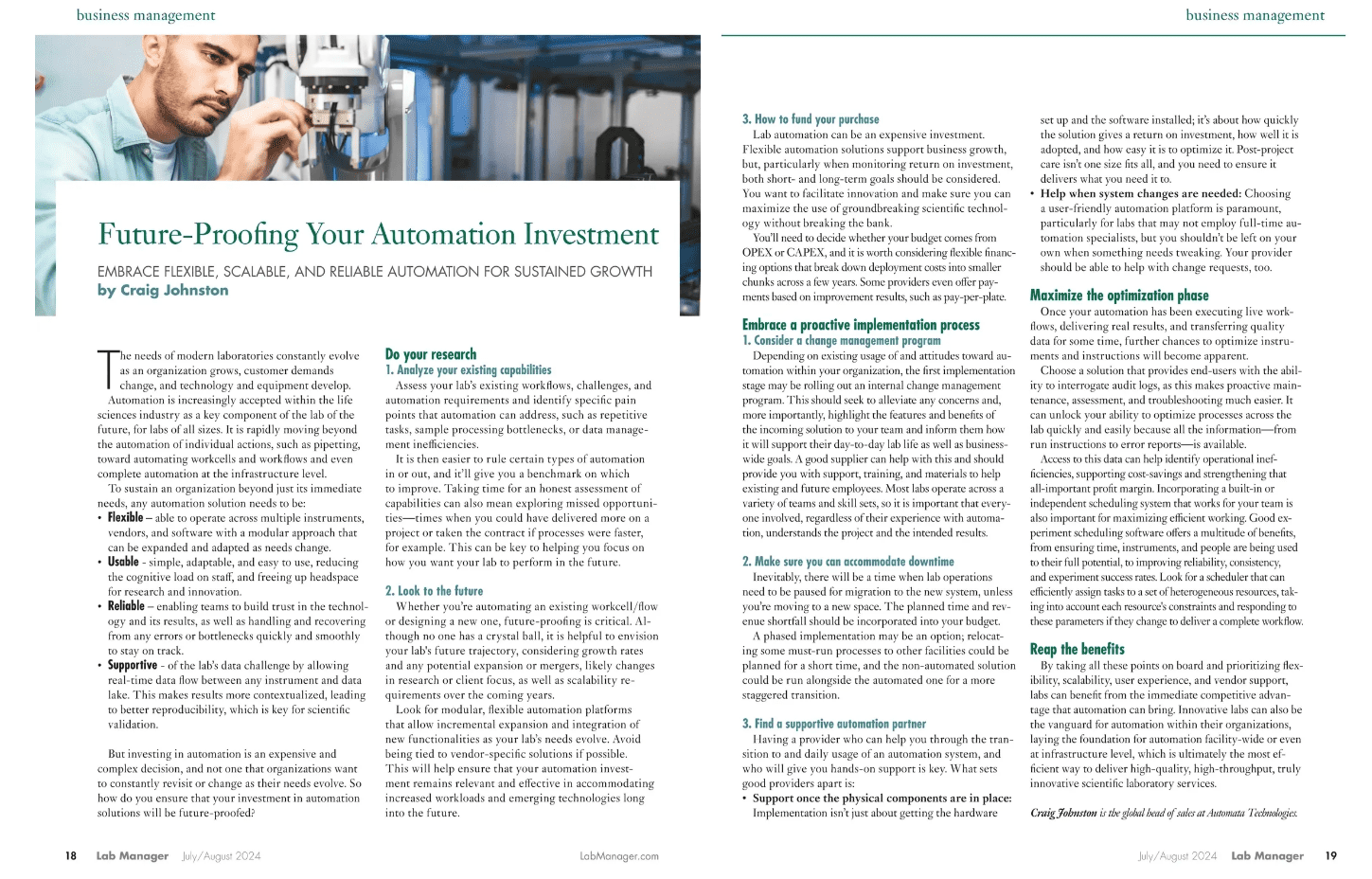This article was first featured in Lab Manager.
By Craig Johnston, Global Head of Sales, Automata.

The needs of modern laboratories constantly evolve as an organization grows, customer demands change, and technology and equipment develop.
Automation is increasingly accepted within the life sciences industry as a key component of the lab of the future, for labs of all sizes. It is rapidly moving beyond the automation of individual actions, such as pipetting, toward automating workcells and workflows and even complete automation at the infrastructure level.
- Flexible: able to operate across multiple instruments, vendors, and software with a modular approach that can be expanded and adapted as needs change
- Usable: simple, adaptable, and easy to use, reducing the cognitive load on staff, and freeing up headspace for research and innovation
- Reliable: enabling teams to build trust in the technology and its results, as well as handling and recovering from any errors or bottlenecks quickly and smoothly to stay on track
- Supportive: of the lab’s data challenge by allowing real-time data flow between any instrument and data lake. This makes results more contextualised, leading to better reproducibility, which is key for scientific validation
But investing in automation is an expensive and complex decision, and not one that organizations want to constantly revisit or change as their needs evolve. So how do you ensure that your investment in automation solutions will be future-proofed?
Do your research
1. Analyze your existing capabilities
Assess your lab’s existing workflows, challenges, and automation requirements and identify specific pain points that automation can address, such as repetitive tasks, sample processing bottlenecks, or data management inefficiencies.
It is then easier to rule certain types of automation in or out, and it’ll give you a benchmark on which to improve. Taking time for an honest assessment of capabilities can also mean exploring missed opportunities—times when you could have delivered more on a project or taken the contract if processes were faster, for example. This can be key to helping you focus on how you want your lab to perform in the future.
2. Look to the future
Whether you’re automating an existing workcell/flow or designing a new one, future-proofing is critical. Although no one has a crystal ball, it is helpful to envision your lab’s future trajectory, considering growth rates and any potential expansion or mergers, likely changes in research or client focus, as well as scalability requirements over the coming years.
Look for modular, flexible automation platforms that allow incremental expansion and integration of new functionalities as your lab’s needs evolve. Avoid being tied to vendor-specific solutions if possible. This will help ensure that your automation investment remains relevant and effective in accommodating increased workloads and emerging technologies long into the future.
3. How to fund your purchase
Lab automation can be an expensive investment. Flexible automation solutions support business growth, but, particularly when monitoring return on investment, both short- and long-term goals should be considered. You want to facilitate innovation and make sure you can maximize the use of groundbreaking scientific technology without breaking the bank.
You’ll need to decide whether your budget comes from OPEX or CAPEX, and it is worth considering flexible financing options that break down deployment costs into smaller chunks across a few years. Some providers even offer payments based on improvement results, such as pay-per-plate.
Embrace a proactive implementation process
1. Consider a change management program
Depending on existing usage of and attitudes toward automation within your organization, the first implementation stage may be rolling out an internal change management program. This should seek to alleviate any concerns and, more importantly, highlight the features and benefits of the incoming solution to your team and inform them how it will support their day-to-day lab life as well as business-wide goals. A good supplier can help with this and should provide you with support, training, and materials to help existing and future employees. Most labs operate across a variety of teams and skill sets, so it is important that everyone involved, regardless of their experience with automation, understands the project and the intended results.
2. Make sure you can accommodate downtime
Inevitably, there will be a time when lab operations need to be paused for migration to the new system, unless you’re moving to a new space. The planned time and revenue shortfall should be incorporated into your budget.
A phased implementation may be an option; relocating some must-run processes to other facilities could be planned for a short time, and the non-automated solution could be run alongside the automated one for a more staggered transition.
3. Find a supportive automation partner
Having a provider who can help you through the transition to and daily usage of an automation system, and who will give you hands-on support is key. What sets good providers apart is:
- Support once the physical components are in place: Implementation isn’t just about getting the hardware set up and the software installed; it’s about how quickly the solution gives a return on investment, how well it is adopted, and how easy it is to optimize it. Post-project care isn’t one size fits all, and you need to ensure it delivers what you need it to.
- Help when system changes are needed: Choosing a user-friendly automation platform is paramount, particularly for labs that may not employ full-time automation specialists, but you shouldn’t be left on your own when something needs tweaking. Your provider should be able to help with change requests, too.
Maximize the optimization phase
Once your automation has been executing live workflows, delivering real results, and transferring quality data for some time, further chances to optimize instruments and instructions will become apparent.
Choose a solution that provides end-users with the ability to interrogate audit logs as this makes proactive maintenance, assessment, and troubleshooting much easier. It can unlock your ability to optimize processes across the lab quickly and easily because all the information—from run instructions to error reports—is available.
Access to this data can help identify operational efficiencies, supporting cost-savings and strengthening that all-important profit margin. Incorporating a built-in or independent scheduling system that works for your team is also important for maximizing efficient working. Good experiment scheduling software offers a multitude of benefits, from ensuring time, instruments, and people are being used to their full potential, to improving reliability, consistency, and experiment success rates. Look for a scheduler that can efficiently assign tasks to a set of heterogeneous resources, taking into account each resource’s constraints and responding to these parameters if they change to deliver a complete workflow.
Reap the benefits
By taking all these points on board and prioritizing flexibility, scalability, user experience, and vendor support, labs can benefit from the immediate competitive advantage that automation can bring. Innovative labs can also be the vanguard for automation within their organizations, laying the foundations for automation facility-wide or even at infrastructure level, which is ultimately the most efficient way to deliver high-quality, high-throughput, truly innovative scientific laboratory services.
Infrastructure-level automation
We’re helping more labs than ever benefit from automation that sits at an infrastructure level, offering the ultimate return on investment.
Find out more in this free-to-access whitepaper, or get in touch with our team to see how LINQ, the complete lab automation platform, could transform your lab.


